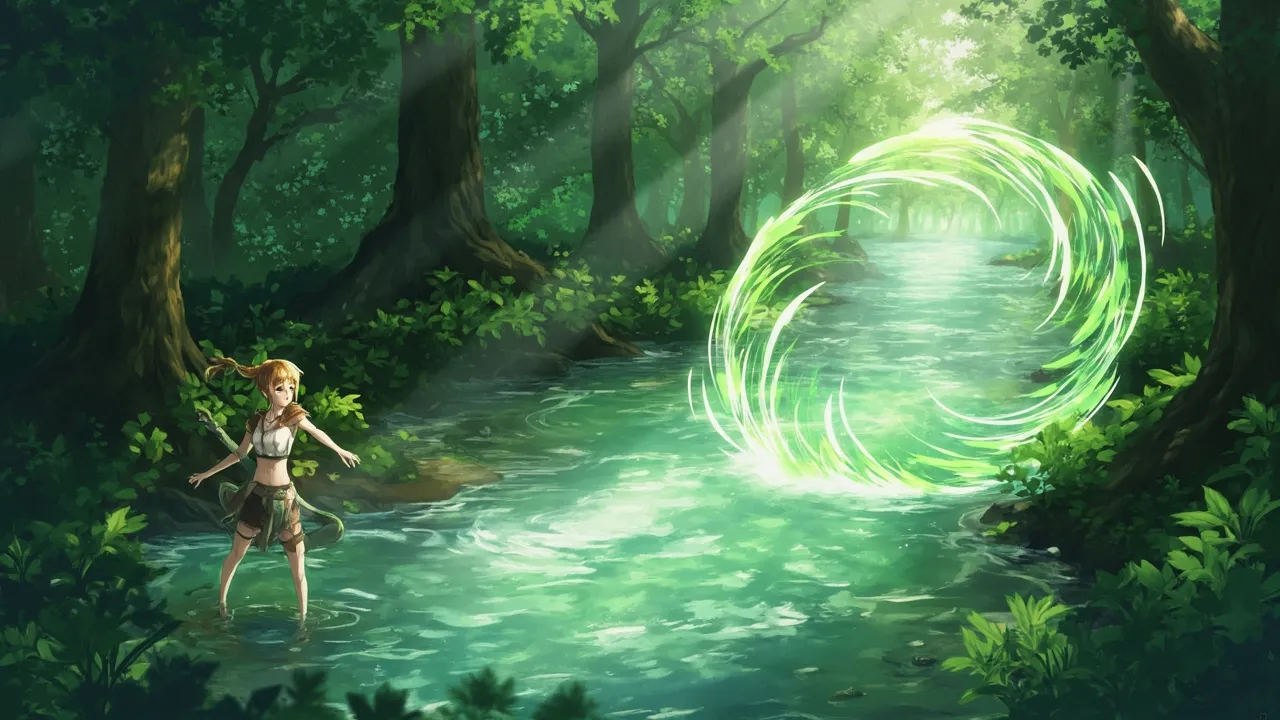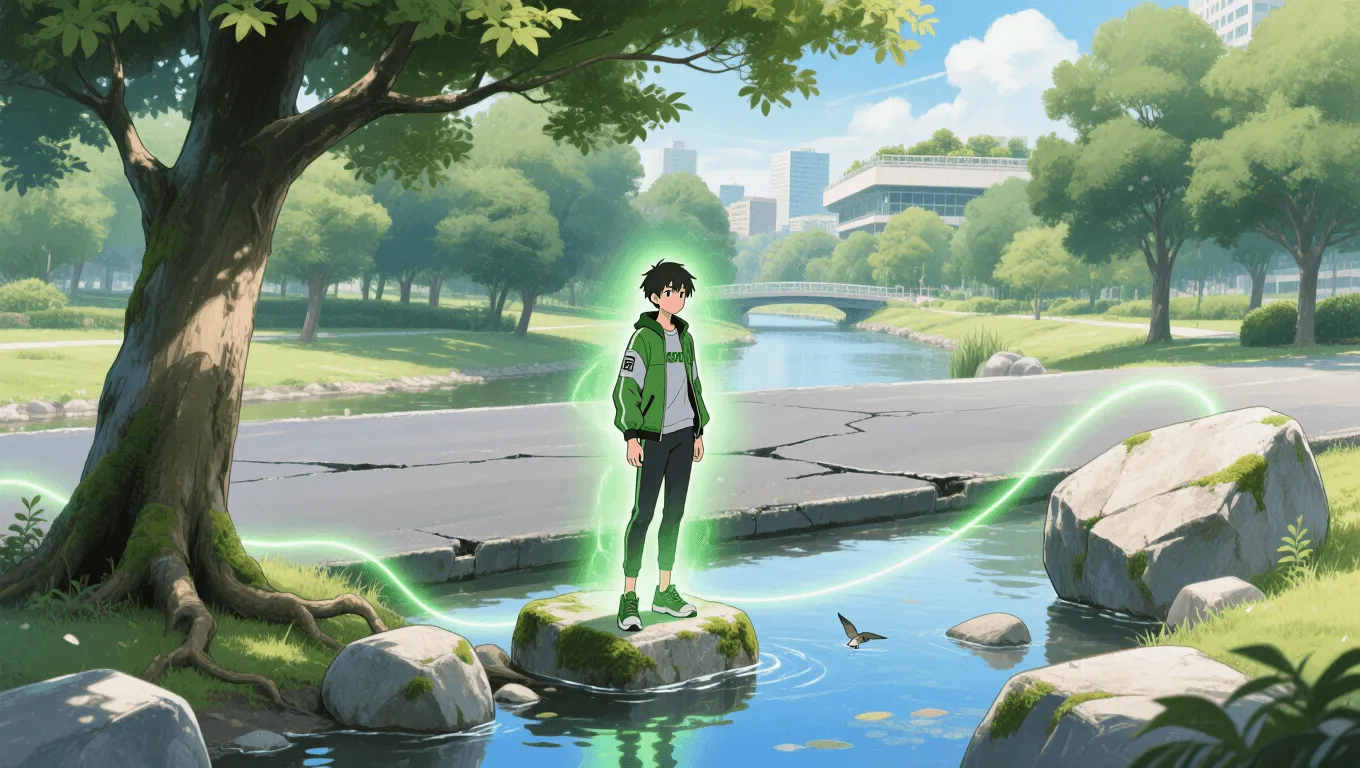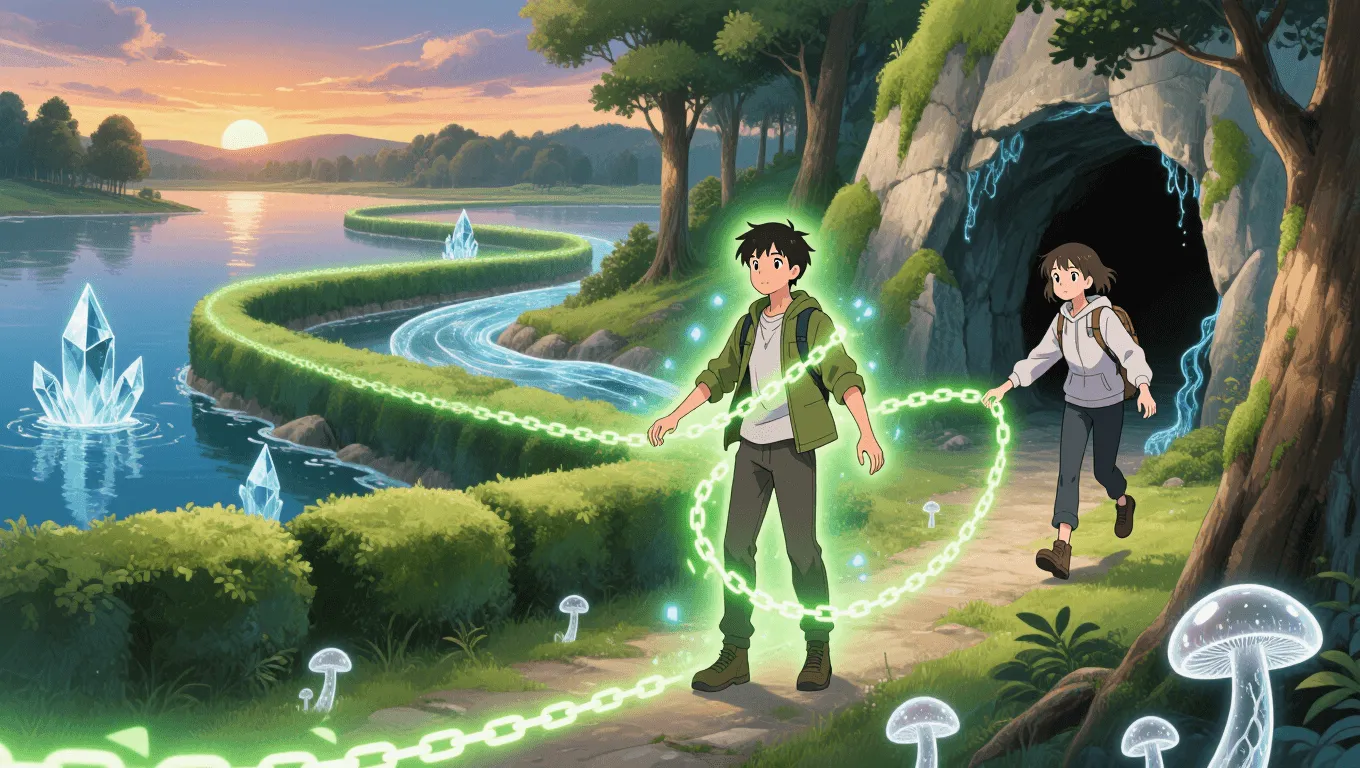Eco-Teleportation

Eco-Teleportation Video Demo 🎬
Table of Contents
What Is Eco-Teleportation
Eco-Teleportation is a movement power that lets a user teleport by traveling through natural elements—trees, vines, water, soil, stone, even fungal networks—and reappear at another connected point in the environment. Instead of opening an artificial rift, the user moves along existing ecological pathways: slipping into a tree trunk, diving into a stream, stepping into a rock face, or sinking through loam to emerge somewhere that shares the same living or geological “circuit.” It’s a form of environment-based teleportation that emphasizes green portals, nature gates, and ecosystem-linked travel. For readers exploring other abilities, browse the evolving list in our superpower wiki or try a surprise pick with the random superpower generator.
Core Abilities of Eco-Teleportation
Nature Anchors and Pathfinding
Eco-Teleportation relies on anchors—distinct natural features that “hold” a waypoint. Mature trees, dense root systems, limestone seams, tide pools, and sprawling mycelial mats are strong anchors. The user senses a lattice of possible exits like a living map, prioritizing routes with the highest ecological continuity (shared species, moisture, soil chemistry, or rock strata). This ecological pathfinding is what makes tree-to-tree or river-to-river jumps feel intuitive and fast.
Flora Gate (Tree-to-Tree Transit)
A classic expression is the flora gate: the user touches bark, the trunk flowers into a dark green aperture, and they step through to another tree within range. Dense forests behave like high-speed transit lines; scattered trees still work but reduce reliability. Practitioners call short hops “leaf-steps” and long-range jumps “canopy shifts.”
Mycelial Network Jump
Fungi knit ecosystems together, and Eco-Teleportation can ride that network. By “tuning” to the mycelium, a user traverses surprising distances underground. This mycelium network teleport is excellent for stealth, infiltration, and bypassing walls; exits often bloom as ringed mushrooms, mossy vents, or soft humus around roots.
Aquatic Slipstream
Bodies of water form superb conduits. Rivers connect to estuaries, caves, and lakes; even underground aquifers can link distant points. The user merges with currents to reappear downstream or in connected basins, a technique nicknamed “blue stepping.” It pairs well with hydrokinesis and maritime operations.
Earthen Step and Stone Conduit
Rock layers and fault lines behave like natural rails for a “stone step.” Granite corridors are stable but rigid; sedimentary layers offer more exits but can shear under seismic stress. Ley lines—places of high geomagnetic harmony—amplify range and reduce fatigue, enabling continent-spanning eco-warp under rare conditions.
Photosensory Scouting
Before committing, the user can “ping” potential exits through photosensory scouting: brief, non-physical impressions gathered from leaves, light patterns, moisture, and microfauna. It’s not full clairvoyance—more like a snapshot of safety, foot traffic, and cover at the destination.
Range, Line-of-Sight, and Cooldowns
Range scales with ecological continuity: a dense, healthy biome yields farther jumps; fragmented or polluted areas shorten them. Line-of-sight isn’t required, but the user must confirm an anchor. After long jumps, a brief cooldown prevents chain-spamming; crossing biomes (forest to desert) demands greater recovery.
Silent Entry and Exit
Eco-Teleportation is quiet. Entrances whisper with leaf-rustle, water ripple, or a soft stone resonance. Exits manifest as unfurling leaves, eddies, or dust motes reforming a silhouette. This makes it superb for stealth insertion and clean extraction.
Environmental Restoration Side-Effect
Passage can leave a small restorative wake: leaves perk up, soil aerates, or algae settle. While minor, repeated use can revitalize stressed patches—handy for eco-first responders and rangers.
Application / Tactical Advantages in Combat
Battlefield Mobility and Flanking
Eco-Teleportation turns forests, parks, wetlands, and cave networks into personal highways. Users can appear behind enemy lines, seize high ground, or bypass kill zones by leaf-stepping along hedgerows or stone-stepping through ridgelines. In urban green belts, even planters and rooftop gardens form a dotted path for surprise angles.
Stealth, Infiltration, and Extraction
Silent entries through tree hollows or tide pools confound surveillance. Users can evade drones, thermal sweeps, and standard tripwires by traveling under canopy or underwater. Extraction is equally strong: wounded allies can be drawn into a trunk aperture and reemerge near field medics, minimizing exposure.
Divide-and-Disrupt Tactics
A defender can bait foes into unsuitable terrain, then vanish into a creek to reappear behind them. Mycelial jumps also cut formations, isolating heavy units from support. Quick “pop-out” strikes—an arboreal jump followed by a stun—allow hit-and-fade engagements.
Reconnaissance and Rapid Logistics
Photosensory scouting offers low-risk intel on patrol routes, humidity levels (implying recent presence), and light shifts that suggest open spaces or campfires. For logistics, Eco-Teleportation moves compact supplies (antidotes, encrypted drives, medkits) across rough country without vehicles or noise.
Civilian Rescue and Sustainment
In disasters, users can reach stranded civilians via river culverts or tree lines, then shuttle them to triage zones. The green portal effect can stabilize soils around exits, helping prevent further collapse in landslides or flood zones.
Level: Level 1 🏙️, Level 2 🌇, Level 3 🌃
Level 1 🏙️ — Green-Line Starter

Beginners anchor to strong, nearby features: mature trees, clean streams, large rocks. Range is neighborhood-scale—city park to park, creek to pond. Cooldowns are longer after each jump, and crossing harsh breaks (asphalt deserts, industrial yards) is taxing. Photosensory scouting yields only minimal impressions: temperature, obvious motion, or glaring light. Ideal use cases: short flanks, quick rooftop garden escapes, basic recon.
Level 2 🌇 — Biome Bridger

At this tier, the user threads multiple anchors like a chain: hedgerow → stream → tree line → cave. Mycelial network jumps become practical, and aquatic slipstreams can link distant lakes. Range expands to regional. The user gains finer control over exit precision (within a few meters) and can carry one passenger or a small payload. Cooldowns shorten significantly. Ideal use cases: coordinated strikes, rescue relays, and supply runs across nature corridors.
Level 3 🌃 — Ley-Walker

Masters read the planet’s ecological currents, tapping ley lines and deep stone harmonics. They can eco-warp across continents under favorable conditions and mask their environmental signature. Photosensory scouting blooms into detailed situational snapshots (footfalls, canopy motion, water turbidity). Level 3 users can tunnel through ecological bottlenecks (e.g., narrow wildlife corridors) with minimal penalty and transport small teams. Ideal use cases: strategic redeployment, clandestine diplomacy, and high-stakes extraction behind fortified borders.
Limitations of Using the Eco-Teleportation
-
Ecosystem Dependence: The power requires real natural anchors. In sterile or heavily paved zones, jumps become short, imprecise, or fail outright. Decorative plastic plants and dry fountains don’t count.
-
Ecological Health Matters: Damaged, polluted, or drought-stricken habitats reduce range. Salt intrusion, chemical runoff, and wildfire scars can scramble pathfinding or cause misjumps to the nearest healthier node.
-
Biome Mismatch Penalty: Crossing sharply distinct biomes (wetland to arid scrub) is possible but exhausts the user and increases cooldowns. Expect nausea, vertigo, or momentary disorientation after harsh transitions.
-
Mass and Volume Limits: Cargo capacity scales with level and anchor strength. Overloading risks “anchor rebound,” ejecting cargo at the entry point or diffusing it to secondary exits (dangerous in combat).
-
Predictability in Repetitive Use: Reappearing from the same oak or cave creates patterns foes can learn. Skilled opponents set traps at common exit points.
-
Anchor Saturation: Rapid consecutive uses through the same feature can “heat” an anchor, temporarily closing it. Users must rotate exits or rest nodes to prevent burnout.
-
Interference by Tech or Magic: Anti-teleport fields, geomagnetic scramblers, or thaumic wards can degrade accuracy, forcing short hops or hard stops.
Weakness Against What Other Superpowers
Pyrokinetic and Desiccation Powers
Intense heat, wildfire conjuration, or targeted desiccation collapses green portals and damages root networks. Dry, brittle anchors drastically reduce jump reliability.
Anti-Teleportation and Spatial Lockdown
Spatial anchors, dimensional clamps, and blink-jammers disrupt the slipstream. Even partial interference can cause bounce-backs or force the user to surface early and exposed.
Urban Density and Sterile Zones
Technopaths or city-shapers who sterilize zones—salted lots, ultra-dry rooftops, sealed concrete plazas—create dead spaces that block nature gates. Long crossings over such gaps impose extreme cooldowns.
Toxins, Blight, and Necrotic Ecology
Poison clouds, blight magic, and necrotic auras foul anchors. Mycelial networks, in particular, are sensitive; a fouled network can misroute exits or strand the user between nodes.
Seismic and Sonic Disruption
Seismokinetics can shake stone conduits; sonic ruptures can scatter water paths and shred fungal filaments, forcing a failed exit or dumping the traveler at a suboptimal node.
Tracking and Scent Powers
Predators with hyper-scent or bio-tracking can follow the subtle restorative scent trail left by exits. While faint, it’s detectable to enhanced senses and skilled trackers.
Synergistic Power Combos
Plant Growth Acceleration
Accelerated vines, saplings, and root webs create fresh anchors, bridging gaps in urban zones. In a pinch, a user can sprout a hopscotch of “vine gates” across a courtyard.
Hydrokinesis
Control of currents extends aquatic slipstreams and allows selective pooling at desired exit points. Teams can surf fast-moving water corridors beneath city streets.
Geomancy / Earth Manipulation
Geomancers shape stone conduits, reinforce brittle rock, and align mineral seams for smoother earthen steps. They can also seal exits behind an ally to block pursuit.
Aerokinesis and Weathercraft
Wind-shapers coax fog and leaf-fall to veil exits, while weather users raise humidity to strengthen plant vitality and extend range on hot days.
Photokinesis and Solar Powers
Light control boosts photosensory scouting and helps charge nearby flora, subtly improving anchor stability. Solar-charged groves make excellent forward bases.
Animal Companionship and Avian Allies
Birds and small mammals can carry spores and seeds to pre-mark future exit points, growing new anchors over time. Rangers plan leap networks weeks in advance using this method.
Illusion, Stealth Tech, and Camouflage
Illusionists mask entry gestures; stealth fields hide the slight ripples of an exit. Together they render eco-warp nearly undetectable until it’s too late.
Known Users
While Eco-Teleportation is a distinct concept, several comic figures demonstrate related nature-based mobility or ecosystem symbiosis that mirrors parts of this power set. Characters like Poison Ivy leverage botanical networks for rapid movement and influence over plant life. Others with deep ties to flora, fungal networks, or living terrains—such as Swamp Thing and Groot—often showcase fast, terrain-linked repositioning or regenerative travel that aligns with eco-warp principles. In various RPG settings, druids, wardens, and forest rangers are common archetypes for this power, especially those attuned to ley lines, mycelial paths, or riverways. For more inspirations and adjacent abilities, keep exploring the broader abilities catalog in the superpower wiki or roll a surprise with the random superpower generator.
